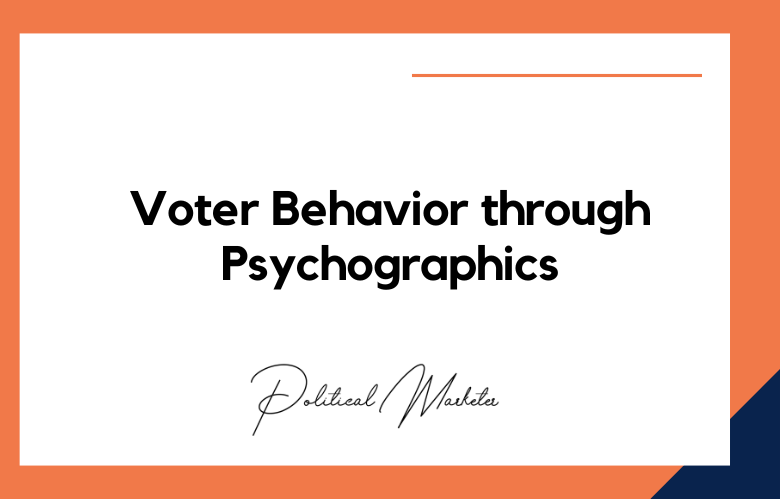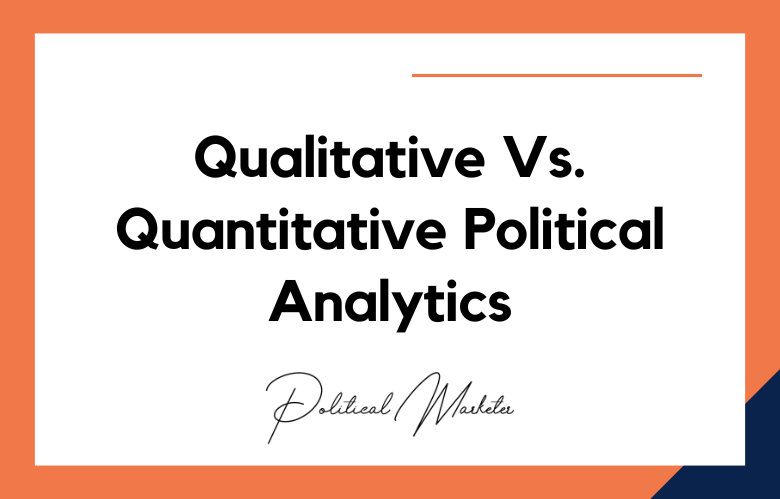In a country as complex and diverse as India, understanding voter behavior is both an art and a science. With over 950 million eligible voters representing diverse castes, religions, languages, economic classes, and educational levels, understanding why people vote the way they do is crucial for any political campaign. Voter behavior in India is influenced by a combination of traditional factors, including caste loyalty, community ties, regional pride, and local leadership, as well as modern influences such as issue-based alignment, development narratives, and emotional appeals. Political success increasingly hinges on the ability to understand not just who the voters are, but what they think, feel, value, and aspire to. This deeper psychological and emotional understanding is where psychographics enters the picture.
Psychographics refers to the study of people’s lifestyles, interests, opinions, values, and attitudes, which extend beyond basic demographic data, such as age, gender, income, or education. In political strategy, psychographics emerged globally in the early 2000s as a tool for microtargeting voters based on behavioral and emotional attributes. In India, the adoption of psychographic methods has accelerated in the past decade, especially with the rise of digital campaigning, data-driven voter outreach, and social media platforms. Parties and campaign consultants now employ psychographic tools to build detailed voter personas—such as the “aspirational first-time voter,” the “culturally conservative homemaker,” or the “social media-influenced urban skeptic”—and tailor their messages accordingly. This shift has transformed political messaging from one-size-fits-all to hyper-personalized narratives that resonate emotionally and align with values.
While demographics classify voters based on quantifiable variables (like age group 18–25 or OBC category), psychographics explores the “why” behind their decisions—why a young urban voter may feel disconnected from traditional parties, or why a retired teacher in rural Bihar might resonate with a campaign based on respect, heritage, and national pride. Demographics tell you who the voter is; psychographics reveal what motivates them. In India, where traditional voting blocs are becoming increasingly fluid and unpredictable, understanding psychographic behavior is crucial not only for mobilizing support but also for shaping narratives that feel authentic and emotionally compelling. It marks a strategic evolution—from counting votes demographically to influencing votes psychologically.
Foundations of Psychographics
Psychographics explores the psychological and emotional factors that influence human decision-making, especially relevant in the context of Indian voters. Unlike demographics, which define who voters are, psychographics explains why they behave a certain way by analyzing values, beliefs, motivations, interests, and lifestyles. In India’s electoral landscape, this means understanding what voters care about—be it nationalism, economic security, spiritual identity, or social justice. These foundations allow political campaigns to segment voters into psychological profiles and craft narratives that align with their emotional triggers, cultural worldviews, and aspirational goals.
Key Psychographic Dimensions: Values, Beliefs, Attitudes, Lifestyles, Interests
Psychographics centers around five core dimensions that shape human behavior.
- Values reflect what individuals consider essential, such as justice, freedom, religious faith, or family honor.
- Beliefs represent what they perceive as accurate, such as trust in a political leader or skepticism toward certain institutions.
- Attitudes indicate approval or disapproval of issues such as reservation policies, taxation, or social reforms.
- Lifestyles describe patterns of daily living, such as urban commuting, digital consumption, or agrarian routines.
- Interests include hobbies, affiliations, and social causes, which influence political messaging preferences.
In Indian elections, voters are influenced not only by economic conditions and community identity but also by their value systems. For example, some urban youth prioritize development and innovation, while others emphasize cultural heritage and national pride.
Role of Personality Traits (e.g., Openness to Change vs. Tradition)
Voters with high openness tend to support reformist agendas, progressive policies, and emerging political alternatives. In contrast, individuals who prefer stability often favor traditional parties or leaders perceived as consistent and reliable.
This distinction is visible in voting patterns across regions. For instance, in states where political churn is high, voters often support change-oriented narratives. In more stable areas, voters may lean toward continuity, tradition, or established leadership.
Campaigns that reflect a voter’s disposition—whether they seek change or favor continuity—are more likely to build emotional resonance and loyalty.
Influence of Media Consumption Habits and Cultural Identifiers
Media consumption strongly shapes political perception. Voters who rely on television news may focus on leadership personalities and national events. Social media users, especially younger audiences, engage with memes, short videos, influencer opinions, and viral content.
Regional language platforms, such as ShareChat, Moj, or WhatsApp groups, create cultural filters through which voters interpret political messaging. Religious affiliations, language pride, regional identity, and social movements also act as cultural markers that influence how voters process political content.
Understanding where voters obtain their information and what cultural cues they respond to enables campaigns to communicate with greater precision and effectiveness.
Psychological Segmentation vs. Traditional Caste/Community-Based Segmentation
Traditional Indian politics often segments voters by caste, religion, region, or class. While this approach remains relevant, it overlooks the psychological motivations that influence decision-making within these groups.
For example, two voters from the same caste may vote differently based on their level of political trust, economic aspiration, or belief in government schemes. Psychographic segmentation categorizes voters based on mindsets—such as aspirational youth, security-focused elders, or anti-establishment thinkers—regardless of their demographic background.
This shift allows political strategists to go beyond identity politics and engage voters based on their beliefs, emotions, and life experiences. When combined with demographic data, psychographics can reveal overlapping motivations within diverse voter blocs, enabling more personalized outreach.
Relevance of Psychographics in the Indian Political Landscape
Psychographics provides a sharper lens for understanding the emotional and cognitive motivations of Indian voters beyond traditional identity markers. As caste-based and regional voting patterns become less predictable, political campaigns increasingly rely on psychographic insights to identify value-driven voter groups, such as those motivated by development, nationalism, or governance reform. These insights enable campaigns to craft narratives that resonate with specific mindsets, whether targeting urban youth, religious conservatives, or economically vulnerable households. In India’s diverse electorate, psychographics enables parties to engage more meaningfully by focusing on what voters think, feel, and prioritize, rather than just who they are demographically.
How India‘s Socio-Cultural Diversity Makes Psychographics Critical
India’s electorate reflects vast social, linguistic, and ideological diversity. Voters in one region may prioritize language rights, while those in another focus on religious expression or economic growth. Traditional voter segmentation based on caste, religion, or region is no longer sufficient to explain electoral outcomes. Psychographics captures the nuances within and across these groups, such as differences in values between two voters of the same caste or economic status.
Campaigns that use psychographic segmentation can engage with these variations more effectively. For example, two rural farmers may both identify as OBC, but one may support a party for its economic policies, while the other may respond to cultural nationalism. Understanding these underlying motivations enables more precise and relevant political messaging.
Comparison of Urban vs. Rural Psychographic Profiles
Urban and rural voters in India show distinct psychographic patterns. Urban voters are more likely to focus on governance quality, digital infrastructure, corruption, and professional aspirations. Their media consumption often includes English or vernacular digital content, influencer commentary, and mobile-first platforms.
Rural voters, while increasingly exposed to digital information, still prioritize issues like agricultural support, caste-based representation, public welfare schemes, and religious identity. Their information sources are regional TV, WhatsApp groups, and interpersonal communication.
Psychographic segmentation considers these behavioral and attitudinal differences, offering campaigns a framework to differentiate messaging across geographic and cultural divides without relying solely on income or occupation data.
Influence of Religion, Nationalism, Social Justice, and Economic Aspiration
Psychographic variables such as belief in national pride, support for religious identity, demand for justice, or pursuit of upward mobility shape how voters evaluate parties and leaders. For example:
- A voter motivated by their religious identity may prefer parties that promise to preserve cultural heritage.
- A first-generation graduate from a Dalit community may support parties offering reservation protections and legal empowerment.
- A middle-class urban professional may focus on controlling inflation, promoting employment growth, and revising tax policy.
Rise of Issue-Based Voting (Employment, Corruption, Identity, Nationalism, etc.)
Issue-based voting is becoming more prevalent across age and class categories in India. Many voters now prioritize specific concerns over party loyalty. For example:
- Young voters may base their decisions on job creation, skill development, or incentives for startups.
- Women voters may respond to issues of safety, healthcare access, or direct benefits.
- First-time voters in urban areas may favor narratives centered around governance and accountability.
- Regional voters in states such as Punjab, Tamil Nadu, or West Bengal may respond strongly to appeals based on linguistic or cultural identity.
This trend reflects a shift from bloc-based voting to behavior motivated by individual interests. Psychographic tools allow political strategists to predict which issues matter most to different voter segments and adjust campaign priorities accordingly.
Psychographic Profiling Techniques Used by Indian Political Campaigns
Indian political campaigns increasingly rely on psychographic profiling to understand voter motivations beyond identity and demographics. Using tools such as behavioral surveys, social media analysis, and mobile app activity tracking, parties segment voters based on values, emotional triggers, and lifestyle patterns. Platforms like WhatsApp, Instagram, and regional content apps help identify distinct psychological traits, such as trust in authority, openness to change, or fear of instability. Campaigns then tailor narratives for specific segments, including job-seeking youth, culturally conservative families, or anti-establishment voters. These techniques allow campaigns to craft targeted outreach strategies that align with each group’s core concerns and beliefs.
Surveys and Behavioral Research (Offline and Online)
Campaigns often begin with structured surveys to capture attitudes, values, lifestyle choices, and political opinions. Offline methods include door-to-door interviews, focus groups, and telephonic polling. Online surveys offer a broader reach and faster turnaround, particularly among urban and younger demographics.
These surveys extend beyond basic preferences by assessing trust in political institutions, perceptions of economic security, willingness to support policy changes, and emotional responses to political symbols. The collected data helps campaigns identify and prioritize key voter segments based on internal motivations.
Social Media Analytics and Sentiment Mining
Social media channels named Facebook, Twitter, Instagram, and YouTube serve as large-scale behavioral datasets. Campaign teams use sentiment analysis tools to track emotional responses to political events, speeches, symbols, and controversies.
These insights allow political strategists to categorize users by tone (supportive, neutral, oppositional), emotional state (anger, hope, fear, pride), and issue interest (jobs, corruption, national security). Rapid shifts in sentiment often serve as early indicators of changes in public mood, prompting real-time adjustments to messages.
Mobile App Behavior and Interest-Based Targeting
Engagement with news, religion, entertainment, e-commerce, or financial apps often reflects lifestyle choices and implicit values.
Targeted advertisements and campaign content are then deployed based on app category, usage frequency, and time of day. For example, users of devotional apps may receive culturally themed messages, while those using finance or job-search apps may see promotions related to economic policy.
WhatsApp Group Activity Analysis and Micro-Community Profiling
WhatsApp remains one of the most powerful tools for political messaging in India. Parties monitor group discussions to identify common concerns, patterns of rumors, emotional language, and shifts in opinion.
Micro-community profiling helps identify localized voter clusters, such as youth study groups, agricultural forums, or caste-based associations. Each group receives customized content tailored to their emotional triggers and group identity. This method allows for low-cost, high-engagement outreach across regions with limited media penetration.
Use of AI and Psychographic Clustering in Voter Data Analysis
Advanced campaigns utilize AI models to identify patterns in voter data and categorize individuals into psychographic clusters. Machine learning algorithms process large datasets that include voter history, digital behavior, income indicators, media preferences, and social interactions.
These clusters may represent profiles such as “aspirational lower-middle-class voters,” “nationalist-leaning urban youth,” or “economically insecure rural women.” Campaigns then build message libraries that correspond to each profile and deploy them through the most effective channels.
The use of AI reduces guesswork and enables precise targeting at scale, although it raises concerns about data privacy, manipulation, and accountability.
Case Studies: Psychographics in Action (India-Specific)
Political campaigns in India have increasingly employed psychographic strategies to segment and influence voters based on their values, beliefs, and motivations, rather than relying solely on identity. Parties like the BJP, AAP, and various regional groups have tailored their narratives to specific voter mindsets—for example, youth aspiring for development, rural voters focused on welfare, or cultural conservatives motivated by nationalism. These campaigns have used targeted messaging, emotional framing, and data-driven outreach to build resonance across diverse psychological profiles. The results demonstrate how psychographics can shape campaign strategies, influence voter perceptions, and impact electoral outcomes.
BJP’s 2019 Campaign: Nationalism, Youth Aspiration, Cultural Pride
The Bharatiya Janata Party (BJP) in 2019 focused on three key psychographic profiles: culturally conservative voters, aspirational youth, and security-conscious citizens. The campaign framed national security, economic self-reliance, and cultural heritage as emotionally resonant themes.
The Balakot airstrike narrative, the “Main Bhi Chowkidar” campaign, and frequent references to cultural pride resonated with voters who held strong nationalist values. At the same time, programs such as Startup India and Skill India were designed to attract urban and semi-urban youth seeking opportunities for progress and employment. BJP’s messaging used symbols, slogans, and digital outreach to appeal to both identity-based pride and forward-looking ambition.
AAP’s Voter Engagement: Anti-Corruption, Governance Transparency
The Aam Aadmi Party (AAP) has positioned itself as a clean and transparent alternative to traditional politics. Its psychographic targeting emphasized distrust in established parties and support for issue-based governance.
By focusing on free public services, decentralization, and visible civic reforms, AAP appealed to voters disillusioned with political corruption and inefficiency. Its messaging strategy prioritized simplicity, credibility, and emotional appeals to fairness and dignity, particularly among lower-middle-class voters, first-time urban voters, and working-class families in Delhi and Punjab.
Regional Parties and Emotional Appeals
Regional parties have long applied psychographic principles, especially when promoting cultural and linguistic identity.
- The Dravida Munnetra Kazhagam (DMK) has consistently tapped into Tamil linguistic pride and values of social justice. Its campaigns emphasize autonomy, regional language preservation, and resistance to perceived cultural imposition.
- The Biju Janata Dal (BJD) in Odisha has adopted a “Odisha-first” mindset, presenting itself as a stable, welfare-oriented force distinct from national parties. Its leadership projects calm, local relevance, and administrative continuity, targeting emotionally secure and regionally loyal voters.
These parties adapt their messaging to match local pride, community sentiment, and regional identity without over-relying on caste segmentation.
Caste-Neutral Campaigns Using Psychographic Frames
Several political campaigns have begun targeting voter groups based on shared concerns or aspirations rather than caste or religious identity.
- Job-seeking youth across states are addressed through economic reform messaging, digital training schemes, and promises of employment opportunities.
- Women voters, particularly in rural and semi-urban areas, are engaged through content that emphasizes safety, access to health services, direct benefit transfers, and education for their daughters.
- First-time voters are targeted through social media influencers, simplified policy explanations, and calls for political change.
This approach focuses on mindset and life stage, enabling parties to connect with diverse voters who share similar psychological drivers but come from different demographic backgrounds.
Integrating Psychographics with Digital Campaign Strategy
Political campaigns in India now combine psychographic insights with digital tools to deliver personalized, emotionally targeted content. By analyzing online behavior, interests, and values, parties tailor campaign messages to match specific psychological profiles across various platforms, including YouTube, Instagram, ShareChat, and WhatsApp. Content is crafted to appeal to distinct segments—such as aspirational youth, culturally conservative families, or anti-incumbent voters—using language, visuals, and tone aligned with their mindset. This integration enables campaigns to enhance engagement, refine message relevance, and shape voter perception through data-driven, emotionally focused outreach.
Personalized Messaging Based on Values and Fears
Political messaging shaped by psychographics targets not just preferences but emotional triggers. Campaigns tailor content to reflect voters’ core values, such as national pride, social justice, or economic progress.
Similarly, campaigns identify and address voters’ concerns, such as unemployment, cultural decline, or corruption. For example, a voter concerned about job security may receive messages highlighting employment programs or economic reforms. At the same time, someone focused on cultural preservation may see content defending local language rights or traditions.
This method shifts the focus from broad promises to emotionally targeted appeals that reflect internal beliefs and anxieties.
Ad Creatives Tailored to Psychographic Segments
Campaigns customize visuals, tone, and storytelling formats to suit different psychological profiles.
- Youth-oriented segments receive meme-based content, influencer reels, or humor-driven ads that reflect their digital habits and informal tone of voice.
- Elder voters are more likely to engage with narratives tied to tradition, faith, stability, or public service. Campaigns use spiritual themes, regional pride, and testimonials from trusted figures to connect with these segments.
Creative decisions—such as color palette, language, imagery, and soundtrack—are calibrated to match the target group’s emotional preferences and cognitive style.
Psychographic-Based Content Targeting on Digital Platforms
Platforms like YouTube, Instagram, ShareChat, and Moj allow campaigns to segment audiences based on behavioral data, interests, and interaction history. Each platform supports different types of messaging formats:
- YouTube serves long-form policy explainers and emotionally charged testimonials.
- Instagram targets younger voters with reels, polls, and carousel ads.
- ShareChat and Moj offer vernacular and culturally localized content to reach voters in Tier 2 and Tier 3 regions.
Using psychographic insights, parties assign platform-specific messages based on attention span, cultural exposure, and emotional preferences.
Using Influencer Marketing Aligned with Psychographic Profiles
Influencers are selected based on the audience segments they attract, not just their follower count.
- A nationalist-leaning influencer may be engaged to promote cultural identity or messaging related to defense.
- Environmentalists are used to amplify content about green policies, rural sustainability, or urban pollution.
- Feminist creators are recruited to frame content on women’s rights, access to health care, or safety.
This method ensures alignment between the influencer’s brand and the voter’s psychological disposition, increasing credibility and message retention.
Challenges and Ethical Considerations in Psychographic Targeting
While psychographic targeting offers precision, it raises serious ethical concerns. Indian political campaigns risk manipulating voter emotions through fear-based or misleading content, especially when targeting vulnerable groups. The lack of transparency in data collection, particularly through mobile apps and messaging platforms, raises privacy and consent issues. Additionally, psychographic strategies can deepen polarization by reinforcing existing biases and delivering one-sided narratives. With minimal regulatory oversight, the misuse of psychological profiling in elections poses risks to democratic integrity, informed consent, and digital accountability.
Risk of Manipulation and Emotional Exploitation
Psychographic campaigns often target emotional vulnerabilities—such as fear, anger, or cultural insecurity—to influence voting decisions. When campaigns prioritize triggering emotional reactions over informing voters, they risk manipulating public sentiment rather than engaging in genuine policy debate.
For example, appeals rooted in fear of the “other,” exaggerated national security threats, or false promises of economic relief can distort electoral choices. These tactics prioritize short-term persuasion over long-term democratic trust, undermining the quality of political discourse.
Data Privacy Concerns in Voter Profiling
Many campaigns collect behavioral and psychological data without explicit consent. Apps, websites, and digital tools often gather user information, including location, browsing patterns, and device use, to infer attitudes and beliefs.
Voters are rarely informed about how their data is being processed or used for profiling. The absence of data protection legislation and weak enforcement mechanisms in India increases the risk of misuse. Without informed consent and clear disclosure, voter profiling may violate individual privacy and democratic norms.
Lack of Transparency in Micro-Targeting and Consent-Based Data Collection
Micro-targeted political ads are rarely visible to the general public. As a result, different voter groups receive tailored messages that others never see, limiting opportunities for public scrutiny or fact-checking.
This opacity allows campaigns to test multiple versions of a narrative, including exaggerated or misleading content, with minimal accountability. Moreover, many data collection methods—such as survey-based profiling or tracking user activity on third-party platforms—lack precise opt-in mechanisms or publicly available terms of use.
Role of the Election Commission and Regulatory Frameworks
The Election Commission of India has given guidelines for social media advertising and paid promotions. However, current regulations do not fully address the complexities of psychographic targeting. There are no precise requirements for disclosing how voter data is collected, segmented, or used to influence opinions.
Stronger oversight is needed to ensure transparency in data handling, ad delivery, and content accountability. This may include mandatory disclosures for political ads, audit trails for data use, and legal penalties for emotional manipulation or privacy violations. Until such safeguards are established, psychographic strategies will continue to operate in a regulatory vacuum.
Future Trends in Psychographic Targeting in Indian Elections
Psychographic targeting in India is moving toward greater precision, automation, and localization. Campaigns are beginning to integrate hyperlocal data with vernacular content to reach specific voter clusters in Tier 2 and Tier 3 regions. Emerging tools, such as AI-driven sentiment mapping, dynamic voter mood boards, and predictive behavior models, will shape future strategies. Political messaging will increasingly adapt in real time based on shifting emotional signals. However, without regulatory reforms, this advancement also risks deeper personalization without accountability. The next phase of political communication will depend not only on technology but also on how it is used responsibly.
Rise of Hyperlocal Psychographic Segmentation Using Vernacular Content
Campaigns are increasingly using regional dialects, cultural references, and locally relevant issues to reach micro-segments. Instead of state-level messaging, content is now tailored for city wards, panchayats, and even neighborhood clusters.
Vernacular content platforms like ShareChat and Moj enable campaigns to engage with audiences by leveraging emotional tone, humor style, religious symbols, and community references. Hyperlocal segmentation combines language familiarity with behavioral profiling to deliver content that feels personal, relevant, and immediate.
Integration of Psychographics with AI-Powered Real-Time Voter Mood Boards
Advanced AI models now process voter interactions across platforms to create live dashboards that track public sentiment. These mood boards visualize changes in emotional tone—such as anger, hope, or anxiety—by region, demographic group, and topic.
Campaigns use these insights to adjust content strategy on a daily or hourly basis. For example, a spike in economic anxiety among middle-class urban voters may prompt a targeted ad rollout focused on issues such as inflation, job security, or fuel prices. This approach turns psychographics into a feedback loop, allowing messages to evolve in sync with public emotion.
Predictive Modeling Using Psychographic Shifts During Campaign Cycles
Machine learning tools increasingly use past psychographic data to predict how different voter groups may respond to future events or policy announcements. These predictions enable campaign teams to test narratives, identify key swing voters, and optimize resource allocation.
For instance, a model may suggest that young rural men are more likely to shift their preferences in response to a defense-related controversy. At the same time, urban women may respond more to safety or price-related content. Predictive tools allow parties to prepare preemptive messaging and refine ground-level operations.
From Profiling to Participation: Using Psychographics to Increase Voter Turnout
Campaigns are beginning to use psychographic data not only to persuade but to mobilize. By understanding why certain groups hesitate to vote—such as apathy, distrust, or logistical barriers—parties can design emotional incentives and community-based interventions to drive turnout.
Messages that focus on civic pride, personal impact, or group identity have been shown to motivate action among disengaged voters. Psychographic targeting can thus move beyond persuasion into participation, turning passive profiles into active voters through tailored engagement strategies.
Conclusion
Psychographics provide a more nuanced understanding of voter behavior in India. Unlike traditional segmentation, which relies on factors such as caste, religion, or region, psychographics focuses on the values, emotions, motivations, and beliefs that drive individual decision-making. This shift enables political campaigns to craft narratives that feel more relevant, build stronger emotional connections, and engage voters on terms that reflect their lived experiences. As Indian politics becomes more competitive and voter preferences more fluid, this approach provides both insight and strategic advantage.
However, the precision of psychographic targeting also demands accountability. While political parties benefit from understanding what voters think and feel, they carry the responsibility to use that insight ethically. Emotional manipulation, fear-based messaging, and opaque data practices undermine public trust and distort democratic participation. Campaigns must resist the temptation to exploit psychological vulnerabilities for short-term electoral gain. Instead, they should commit to transparent, consent-based profiling methods and prioritize message integrity over influence engineering.
Voters, too, have a role to play. Increased public awareness about how personal data is used for political persuasion is essential for an informed electorate. Citizens must critically evaluate campaign messages, question emotionally charged content, and demand greater transparency in digital political advertising. As psychographic methods become more advanced, protecting democratic values will depend not only on ethical political practice but also on an active, informed, and rights-aware voter base.
Understanding Voter Behavior Through Psychographics: FAQs
What Is Psychographics In The Context Of Indian Elections?
Psychographics refers to the analysis of voters based on their psychological traits, including values, attitudes, beliefs, interests, and lifestyle preferences. It helps political campaigns understand why people vote a certain way, beyond their caste, age, or income.
How Is Psychographics Different From Demographics?
Demographics identify who a voter is (e.g., age, caste, gender, religion), while psychographics focus on what motivates them, such as emotional triggers, ideological leanings, or lifestyle goals.
Why Is Psychographic Profiling Gaining Importance In Indian Politics?
As Indian voters become less predictable and more issue-driven, psychographics enable campaigns to craft emotionally resonant, targeted messages that align with voter mindsets across diverse communities.
What Are The Core Dimensions Of Psychographics?
The primary dimensions include values, beliefs, attitudes, interests, personality traits, and lifestyle patterns. These shape a voter’s psychological profile and influence their political behavior.
How Do Political Parties In India Collect Psychographic Data?
They use a combination of offline surveys, digital behavior analysis, social media monitoring, app usage data, and community-level feedback to build psychological voter profiles.
What Is Sentiment Mining In Political Campaigns?
Sentiment mining refers to analyzing public reactions and emotional tones across social platforms to understand voter moods and adapt messaging accordingly.
How Do WhatsApp Groups Contribute To Psychographic Profiling?
Parties monitor discussions in local WhatsApp groups to identify shared concerns, emotional reactions, and micro-communities, allowing for tailored messaging based on group sentiment.
Can Mobile App Behavior Reveal Voter Psychology?
Yes. App usage patterns, such as time spent on news, religious, or finance apps, often signal a user’s priorities, enabling campaigns to infer values and emotional drivers.
How Did The BJP Use Psychographics In The 2019 Election?
The BJP targeted nationalist sentiments, youth aspirations, and cultural pride by crafting segmented campaigns based on emotional appeals and developmental promises.
What Psychographic Strategies Did AAP Employ?
The AAP utilized anti-corruption messaging and governance transparency to connect with disillusioned urban voters, particularly first-time voters and working-class families.
How Do Regional Parties Apply Psychographics?
Regional parties focus on local pride, linguistic identity, and emotional concerns. For instance, DMK emphasizes Tamil identity, while BJD promotes Odisha-first narratives.
What Are Caste-Neutral Psychographic Campaigns?
These campaigns target specific psychological segments, such as job seekers, young women, or first-time voters, without referencing caste or religion; instead, they use shared concerns to shape their outreach.
How Are Digital Platforms Used In Psychographic Targeting?
Platforms like YouTube, Instagram, ShareChat, and Moj enable parties to target custom content to segmented audiences based on platform behavior and emotional preferences.
What Are Real-Time Voter Mood Boards?
These are AI-generated dashboards that visualize voter emotions such as anger, hope, or anxiety across locations and groups, enabling rapid response messaging.
What Is Predictive Modeling In Psychographic Campaigns?
Predictive modeling uses past psychographic data to forecast how certain voter groups will respond to upcoming events, controversies, or policy announcements.
Can Psychographic Data Be Used To Increase Voter Turnout?
Yes. By identifying reasons for voter apathy, such as distrust, fear, or disinterest, campaigns can create personalized messages that encourage civic participation.
What Are The Ethical Concerns Around Psychographic Targeting?
These include emotional manipulation, misleading content, fear-based messaging, and exploiting vulnerable voters using psychological pressure.
Do Data Privacy Laws Protect Indian Voters During Campaigns?
Currently, India lacks a comprehensive legal framework governing the use of political data. Most psychographic data collection happens without transparent consent or regulation.
Does The Election Commission Of India Regulate Psychographic Targeting?
The ECI regulates digital advertising but has limited oversight over psychographic profiling, microtargeting methods, or algorithmic content delivery.
What Can Voters Do To Protect Themselves From Manipulation?
Voters should critically evaluate political content, avoid emotionally charged misinformation, ask how their data is being used, and demand greater transparency in campaign advertising.











